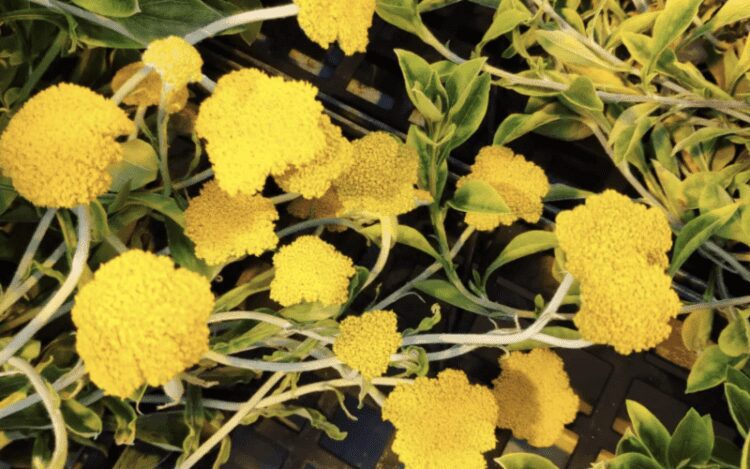The woolly umbrella plant, scientifically known as Helichrysum umbraculigerum, is a perennial herb with a velvety yellow exterior, indigenous to South Africa. Interestingly, scientists from Israel have recently found that this plant, despite not being part of the cannabis family, produces several cannabinoids, which were previously thought to be unique to cannabis and hemp plants.
The recent findings could pave the way for new prospects in cannabinoid medications and therapies. The research, dubbed “A Fresh Perspective on Cannabinoids,” was undertaken by investigators from the Weizmann Institute of Science and was featured in the Nature Plants journal earlier this month.
The Link between Cannabis and the Woolly Umbrella Plant
Cannabinoids and their potential applications have been a subject of research for many years. The most recognized cannabinoid is usually THC, although a number of others have gained attention over time, with minimal to zero psychoactive effects, and could help in alleviating various symptoms and conditions.
Even though cannabis is recognized for producing over 100 distinct cannabinoids, the research group detected more than 40 cannabinoids in the woolly umbrella plant. They also unveiled the biochemical process the plant undergoes to generate these compounds, and how this process can be replicated in a lab to synthesize existing cannabinoids or possibly create new ones not found in nature.
“We have uncovered a significant new source of cannabinoids and created methods for their consistent production, which could facilitate exploration of their immense therapeutic potential,” stated the study’s lead, Dr. Shirley Berman from the Weizmann Institute of Science.
The woolly umbrella plant, a cousin of daisies, lettuce, and sunflowers, can grow up to a meter tall and is commonly used to construct garden borders. It has also been used in traditional rituals to produce intoxicating smoke, suggesting there might be more to it than meets the eye.
Over 40 years ago, German scientists discovered evidence of cannabinoids in the woolly umbrella, but subsequent studies couldn’t replicate these findings until now. The research team initiated the study of the woolly umbrella specifically to re-explore its connection with cannabinoids and broader potential as a therapeutic aid.
A New Era for Cannabinoids?
To verify the early reports, the researchers employed cutting-edge technology. They sequenced the complete woolly umbrella genome and utilized sophisticated analytical chemistry to identify the cannabinoids it possesses. They were also able to establish the exact structure of over a dozen of the detected cannabinoids, as well as other related metabolites.
They discovered that the woolly umbrella primarily generates cannabis in its leaves, which could offer an advantage over cannabis, which synthesizes cannabinoids in the ephemeral, sometimes difficult-to-harvest flower clusters. Nonetheless, researchers identified many similarities between the two plants, especially that the enzymes involved in each stage of cannabinoid production belong to the same families.
The researchers identified six cannabinoids in the woolly umbrella that are identical to those in cannabis. THC and CBD were not among them, but CBG, or cannabigerol, was. CBG has seen a surge in interest, as ongoing research continues to uncover its potential therapeutic advantages. Like CBD, this cannabinoid does not produce the psychoactive effects associated with a “high.”
In the case of cannabis plants, CBG is viewed as the primary precursor to many popular cannabinoids. Specifically, THCA, CBDA, and CBCA all originate from CBG’s acidic form, CBGA. This often results in limited CBG available for harvest in mature plants. While growers have sought alternatives to enhance CBG production, the woolly umbrella may introduce a new approach.
An Encouraging Discovery for Future Research
Furthermore, the researchers underscored that there’s an ecological aspect that warrants further scrutiny. The reasons behind why plants produce cannabinoids are still not entirely understood by scientists, though some evidence points towards its possible role in repelling predators or providing protection against ultraviolet rays.
“The fact that two genetically disparate plants developed the capacity to produce cannabinoids independently throughout evolution suggests that these compounds serve critical ecological roles,” stated Professor Asaph Aharoni, whose laboratory was utilized for the study. “Further research is needed to ascertain what these roles might be.”
Looking ahead, the discoveries from this study could enable scientists to engineer cannabinoids not found in nature, potentially leading to improved binding to human cannabinoid receptors or even specific therapeutic effects. The cannabinoids unique to the woolly umbrella plant may also possess untapped potential.
“The following intriguing step would be to understand the properties of the over 30 new cannabinoids we’ve identified, and subsequently explore their potential therapeutic applications,” Berman added.
RELATED: Researchers Find CBD-Like Compound in South American Shrub









